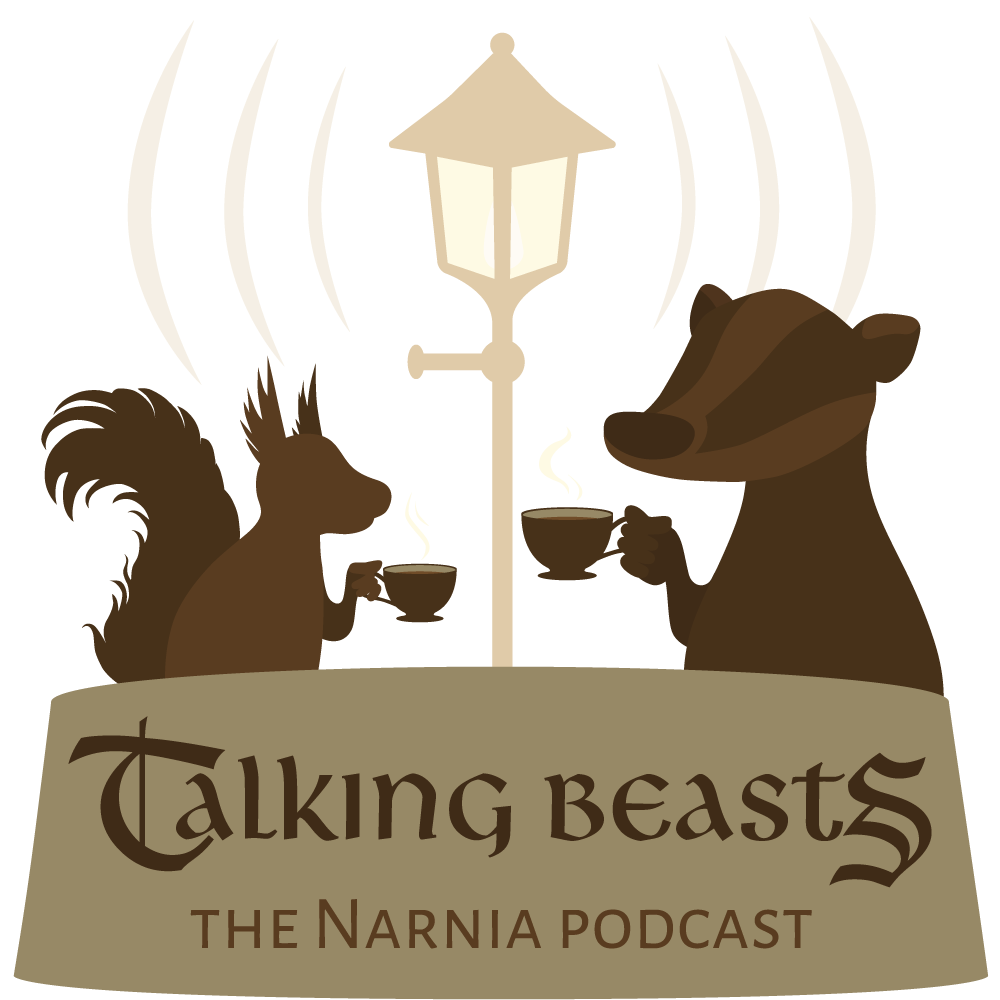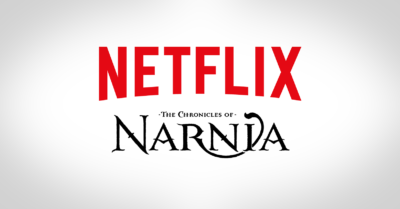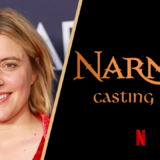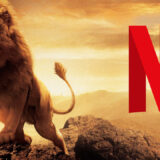Report: The Narnia Exhibit at the Royal Armouries Museum
NarniaWebber Jints recently returned from the Weta Workshops Narnia and Lord of the Rings weaponry exhibit at the Leeds Royal Armouries Museum. This is her report.
I apologise in advance, but I suspect I’m going to overuse the word ‘massive’ in the following report. For one thing, I don’t have a thesaurus handy, and for another, it was truly the one word that kept coming to me during my trip to the Leeds Royal Armouries Museum. Weta Workshops had sent over a bundle of the weapons and armoury used in The Lord of the Rings, King Kong, Hellboy, The Last Samurai and, of course, The Chronicles of Narnia: The Lion, the Witch and the Wardrobe. The exhibition is free, and a special Narnia evening was announced for 14th August. Wild horses, and all that…
Sadly, though, the first ‘massive’ is the massive disappointment I had just before I was due to travel the Leeds. The Museum had to cancel the special Narnia-themed evening I’d booked my trip around… but I’d already bought my train tickets, already booked the hotel room, so off I went anyway.
(It was cancelled due to lack of ticket sales. Where were you guys? You’ve let the good side down…)
The second ‘massive’ is the size of the museum. Jings. It. Is. Hay-uge. Not surprisingly, it looks like a fortress itself, though it’s not in a location that needs much defending.
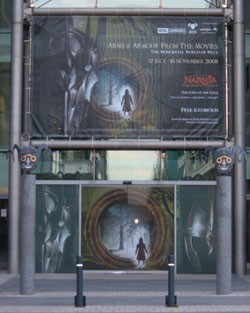
Entrance to the Leeds Royal Armouries Museum
The design they’ve put on the museum doors is excellent; Narnia/LotR fans should feel a tremble of geekery flow through them as the doors slide open and they walk past Lucy through the hobbit-hole doorway. With hindsight I ought to have made sure a person was in that shot, for reference. I think I remember ‘door’ Lucy being about the same height as me, and I’m about 5’7”.
I think I managed to look like I knew where I was going once I got inside… a frantic scan of the signs came up with the instruction to go to the fifth floor, and a nonchalant wander to the back of the museum ended in the serendipitous discovery of the lifts… up I go… the doors open… now what?
Ah… now these…
Wetas all over the walls, and arrow-formation wetas all over the floor… !
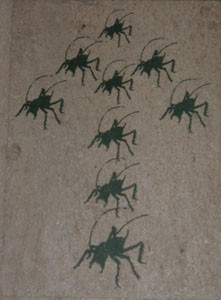
Weta arrows
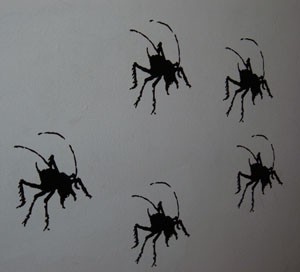
Wetas on the floor
On the way around I passed some displays that were linked to King Kong and The Last Samurai. They comprised only two glass cabinets, and I admit at that point my heart sank that the Narnia bit might end up to be a bit of a damp fizzle compared to the fireworks display of my imagination… but upon reading the information panels, I realised that these were just museum pieces of the sort of weapons that were around at the times these movies were set. Phew!
(By this time I was unsure if any photography would be allowed, so I put my camera away.)
Past the King Kong/The Last Samurai cabinets and round a corner were a number of information boards that take you through the story of Weta from its origins to the present day, including biographies of the main players in the company. They even had a board on ‘What is a Weta?’ — I copied down the description of ‘bizarre and prickly prehistoric cricket’. Nowhere on the boards was it written ‘WETA’.
While I’d been scanning the ‘Who’s who’ boards, part of The Lion, the Witch and the Wardrobe soundtrack started blaring out from an unseen speaker. I reckon that music will always stir my blood, no matter where I happen to be. Just as well, in this case, as I’d already had to go up five floors (albeit in a lift), pass down two corridors, go round two corners and I still hadn’t reached the main exhibition. That was one of the few marks against the experience; it did sort of feel like it was stuck up in the spare back attic of the museum. Further up and further in, indeed, although I doubt the organisers were being that clever — I think it’s the only space they have…
Finally. One more corner and then — the entrance! I didn’t have to go three steps down and five up, thankfully.
And hey, look at that! Visitors enter through a doorway that’s framed with wood that matches ‘the’ wardrobe, and then have to pass a rail of fur-esque coats before reaching the exhibition pieces. For extra points, they could have set it up so you needed to really push the coats out of the way, I thought, but then there’s probably some health-and-safety laws that would be flouted if they did that. And were plastic coat hangers likely to appear in the old, disused wardrobe of a large country house in the 1940s? (You know you’re a Narnia geek when…)
So there I was! And here’s what I saw… I had to make do with notes as by this point it had been made very clear that camera use was not allowed.
1. Peter’s armour, sword and shield.
What a way to start! What struck me first was the size of it… no, not massive! The opposite, really — it was definitely a suit of armour for a growing boy. When I took a look around the rest of the museum later on and thought of Peter’s kit, I appreciated a little better how Peter had to become King while still young. It was a shame they didn’t get the full costume; the tabard looks like it is made from thin red cotton, and the lion rampant emblem on the front looked like it was taken from a giant’s fuzzy felt ‘Jungle Animals’ set. Second mild downer. Still, this is an armouries museum, and doesn’t seem to go in for ‘costumes’ unless they contain hidden steel plates or can ‘magically’ produce daggers from the wearer’s sleeve.
2. Susan’s bow, quiver, arrows and horn.
Lovely, lovely, lovely. Despite that fact that I (and many of you reading this) already know all about how and why Susan’s gifts are carved the way they are (daffodil motifs and Aslan’s image, etc.), to see it this close was brilliant. In fact, that can be said for all the pieces on display.
3. Edmund’s helmet, sword and shield.
Talk about Pete’s armour being ‘youth sized’; Ed’s helmet is obviously smaller still! The stylised Aslan design on Ed’s shield is my favourite Aslan-inspired design of the lot.
It was at this point, after about 15 minutes, that I realised the music was on a very short loop. I’d not noticed the repetition before, but it proceeded to bug me all the rest of the time I was there. Downside # 3.
4. Lucy’s dagger.
Ohhh, it’s tiny. And just to redress the descriptive balance, it must’ve taken a massive amount of work. The information panel said the creators had wanted to make it a more ceremonial piece than an actual weapon, because it belongs to a young girl… they succeeded, because to me it does have echoes of an extremely sharp and fancy letter opener.
Another point made on the info panel was that the Aslan’s head shape to the hilt of the dagger matched that on the pommel of Peter’s sword, to show the bond between brother and sister. I was impressed by that.
By now a number of groups/individuals had passed me by, as I was taking a long time jotting down notes and gazing at every detail my eye could see. I was very well-behaved, though, and managed not to correct all the people who made inaccurate comments in passing. Aren’t you proud? I was beginning to notice, however, that the majority of gasps and exclamations of ‘Wow’ and ‘Cool!’ and ‘Look at that!’ came from the bad guys’ side of the display rather than the good guy side. Tsk.
5. Oreius’ armour and swords.
And boy, do they mean swords (the two-handed variety). There’s the real one and a mock-up. Both are massive, and according to the info panel the real thing alone took 120 hours to make. Yikes.
6. Centaur saddlery and horn.
To the right of the Oreius’ gear was a mannequin attached to one of the wheeled rigs the actors had to wear to ‘be’ a centaur, to fully display the saddlery get-up. It must’ve been pretty heavy, especially with all the weaponry strapped in. Steel on wheels, ha ha.
Sorry.
In front of that was a centaur’s horn, much bigger and longer than Susan’s, but the metallic parts of it looked in need of a darn good scrub with some polish.
7. A red dwarf’s helmet, arming cap, gorget, bows and horn.
The reddish design on the gorget looks a bit like it got rusty in a very artistic way, but I’m sure that’s not what happened. This piece perhaps suffered from appearing between two sets of massive centaur weaponry, and hence it got a bit overlooked.
8. Centaur swords, javelins, breastplate and shield.
Now this is massive on a massive scale. Just before I started reading all the info panels for this section, I wondered why the design on the shield was Aslan above what looked like the lower half of a sun. What was the significance? I’ve seen enough of Weta’s work by now to know that they very rarely ever adopt a motif ‘just because’, but I didn’t know the ‘why’ in this case.
Thankfully, right there on the info panel it said that they imagined centaurs to belong to two clans, and each clan had its own designs and materials: the Sun clan design featured sun motifs, and the weaponry used brass and bronze mounts and oak hilts, while the Moon clan armour would be made of silvery steel pommel caps and olive wood hilts, and the designs on the armour would represent starry constellations. Aren’t I clever? I hadn’t read that anywhere else (or if I did, I’d forgotten it!). My personal favourite set was the Moon designs, as I like Art Deco and it was along similar lines.
Let me insert a comment that I heard at about this stage in my viewing. One gentleman commented to his companion that the pieces were all made ‘surprisingly’ to a ‘high standard’. I did almost choke, but I didn’t say a thing.
9. Faun armour, helmet, shields, swords and glaive.
I don’t care how loudly the experts say ‘it’s for protection, not appearance’, I’ll always find the ear-flaps on the faun helmets extremely cute.
These pieces were all almost exclusively red leather, which made a mind-refreshing change from all the steel I’d just seen. There were the two faun swords, though, not made of leather — they were quite different but both had curved blades. After all the very strong nods to Aslan in the previous sets, it was easy to notice that he wasn’t featured on the fauns’ things. However, as the info board said, it was the red and gold colours used for the armour that spoke of the allegiance of the fauns to their King.
And that was the end of the good guy display. It was all contained in one glassed-off area, and behind the Pevensie section there was a lamppost, a good sign that some care and thought had gone into the set-up.
You could tell it wasn’t a Narnia nerd that had done it, though… the lamppost had two arms. Oy.
Right. On to the bad guys.
1. Giant’s club.
Not actually much to say, here. It was made to look like a broken cattle yoke, which does quite effectively show the laziness/lack of skill of the giants.
2. Boggle axes, and axe and dagger of Marsh Horrors.
[NB Boggles = underground dwellers. Marsh Horrors = forest dwellers… just for all the ‘I still remember the details of the book much better than those of the film’ folks, like me!]
The Boggle stuff was quite thick and clunky, not much artistry to it at all. The Marsh Horror stuff was much more ‘refined’, in that it all features some sort of serpentine nature in its design, and was thin and cruel-looking. For instance, the hilt of the dagger is a snake, and it’s the mouth of the snake that grasps the blade of the dagger.
3. Minotaur arms and armour.
Yep, this was what inspired a lot of the ‘Wow’ comments from any boys passing through. Heavy, brutal, crazy-looking stuff. The sword design was taken from the design of an Ancient Egyptian sword called the kopesh. I’ve no idea how it would be used properly. Curved, then curved again. Barmy. Terrifying.
The breastplates were covered in leering faces, known as the Green Man, solitary staring eyes, bat wings, gorgons and more serpents. This was all inspired from 16th century Italian armour, and looking closely shows that they’ve even made the rivets that joined the pauldrons to the breasplate the eyes of jeering wee faces to disguise them and further the impact.
(I was told this by a gentleman who had ‘appeared’ beside me — well, my nose was buried in my notebook and I was busy scribbling — and he turned out to be the exhibition curator. By the time I had properly surfaced and his introduction has sunk in, he’d gone… argh! But he did tell me Richard Taylor would be there on 15th and 16th October — be there!)
It struck me that while the good Narnians would fight with, at most, the symbol of Aslan on their shields or breastplates, these bad guys covered themselves in any and every dark symbol they could think of. Just in case it’d help.
It didn’t. Ha!
4. Cyclops armour and axe.
This stuff showed some proper allegiance to the White Witch, as it featured stylised snowflake motifs. (Sorry, after all that stuff packed on the minotaur display, whatever followed it seemed a bit diluted.)
5. Black Dwarf armour and arms.
No similarity at all in design or shape to the armour of the red dwarf. In fact, I’ve not noted any particular design features at all, so it must have looked rather basic.
6. Ginarrbrik’s knife.
Another curved blade. The info panel desribes it as a ‘skinning knife’, which explains the deer horn handle and anter motif on the blade near the hilt.
7. Otmin’s armour and sword.
Massive, massive sword. Similar-themed breastplate to the other minotaur stuff, only his also features two ankle slicers.
8. The White Witch’s wand and stone dagger.
Ooooo-ooooh! I know I commented with mild reproof on how the bad guy side was getting more interest than the good guy side, but I admit that the knife was the coolest piece in the collection. The wand was actually smaller than I’d expected, and most definitely in one piece. The knife was made to look like it was obsidian, a black volcanic stone. It was massively cool. I was particularly attracted by the silver filigree work on the stone — also featured on the wand — which reminded me of veins of ice stealing their way along the weapon. Shiver.
You can’t expect that to be topped, really, and it wasn’t. That was the end of the Narnia section. If I turned 180 degrees and went past the faun armour, I’d end up walking through a hobbit-hole doorframe to the LotR display.
Did I?
Of course! But this is not a Lord of the Rings website! Trust me, it’s a brilliant exhibition and had many more drool-worthy pieces to add to what I’ve described above (Sauron’s helmet! Impossibly thin elf armour! Theoden’s massive sword! Sting, both Elijah Wood-sized and scale double-sized!… yes, I was so frazzled by that point I had to read the info card to work out why there were two of them…). But if you want to read more about that you’ll need to look elsewhere, or even better, go and see it for yourself!
The museum on its own is stupendous and I’d recommend a trip to it at any time, even once the Wetas have been taken off the walls. What’s so brilliant about this exhibition being held in an armouries museum, instead of on its own or in a film museum, for instance, is that you can then go and see the real thing — you can look at pieces from throughout history that feature the designs that the Weta folk used for inspiration.
Go and seek out the Wetas on the walls. Don’t risk giving yourself a massive kick for missing it!
The exhibit will be on display until November 16, 2008. Thanks Jints!

